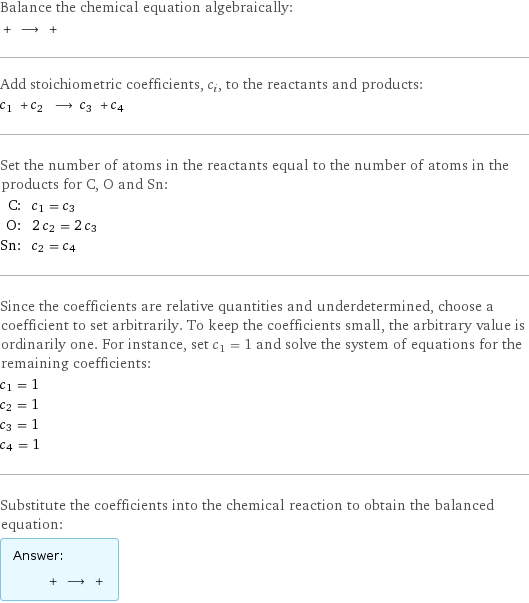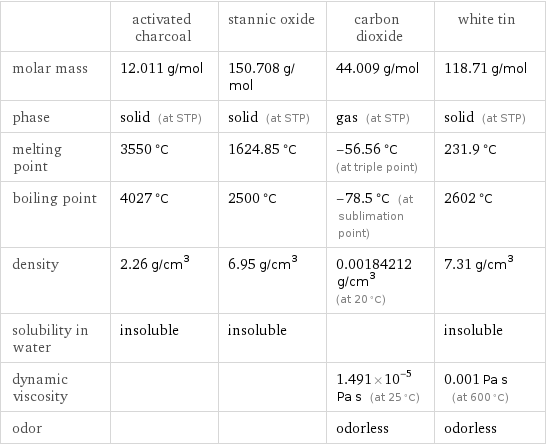Input interpretation

activated charcoal + stannic oxide ⟶ carbon dioxide + white tin
Balanced equation

Balance the chemical equation algebraically: + ⟶ + Add stoichiometric coefficients, c_i, to the reactants and products: c_1 + c_2 ⟶ c_3 + c_4 Set the number of atoms in the reactants equal to the number of atoms in the products for C, O and Sn: C: | c_1 = c_3 O: | 2 c_2 = 2 c_3 Sn: | c_2 = c_4 Since the coefficients are relative quantities and underdetermined, choose a coefficient to set arbitrarily. To keep the coefficients small, the arbitrary value is ordinarily one. For instance, set c_1 = 1 and solve the system of equations for the remaining coefficients: c_1 = 1 c_2 = 1 c_3 = 1 c_4 = 1 Substitute the coefficients into the chemical reaction to obtain the balanced equation: Answer: | | + ⟶ +
Structures

+ ⟶ +
Names

activated charcoal + stannic oxide ⟶ carbon dioxide + white tin
Chemical names and formulas

| activated charcoal | stannic oxide | carbon dioxide | white tin Hill formula | C | O_2Sn | CO_2 | Sn name | activated charcoal | stannic oxide | carbon dioxide | white tin IUPAC name | carbon | | carbon dioxide | tin
Substance properties

| activated charcoal | stannic oxide | carbon dioxide | white tin molar mass | 12.011 g/mol | 150.708 g/mol | 44.009 g/mol | 118.71 g/mol phase | solid (at STP) | solid (at STP) | gas (at STP) | solid (at STP) melting point | 3550 °C | 1624.85 °C | -56.56 °C (at triple point) | 231.9 °C boiling point | 4027 °C | 2500 °C | -78.5 °C (at sublimation point) | 2602 °C density | 2.26 g/cm^3 | 6.95 g/cm^3 | 0.00184212 g/cm^3 (at 20 °C) | 7.31 g/cm^3 solubility in water | insoluble | insoluble | | insoluble dynamic viscosity | | | 1.491×10^-5 Pa s (at 25 °C) | 0.001 Pa s (at 600 °C) odor | | | odorless | odorless
Units
